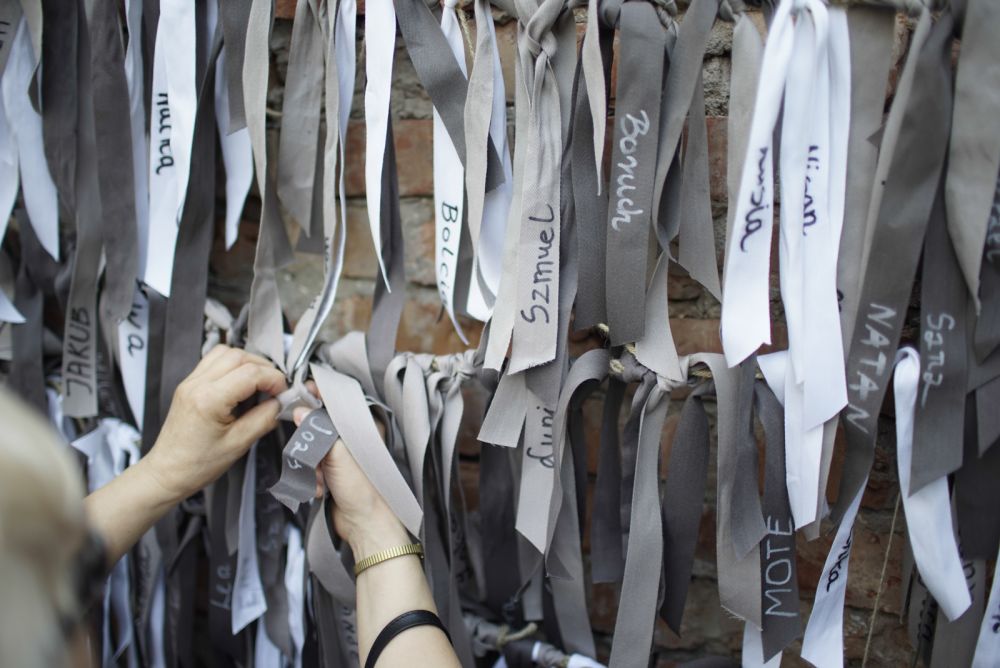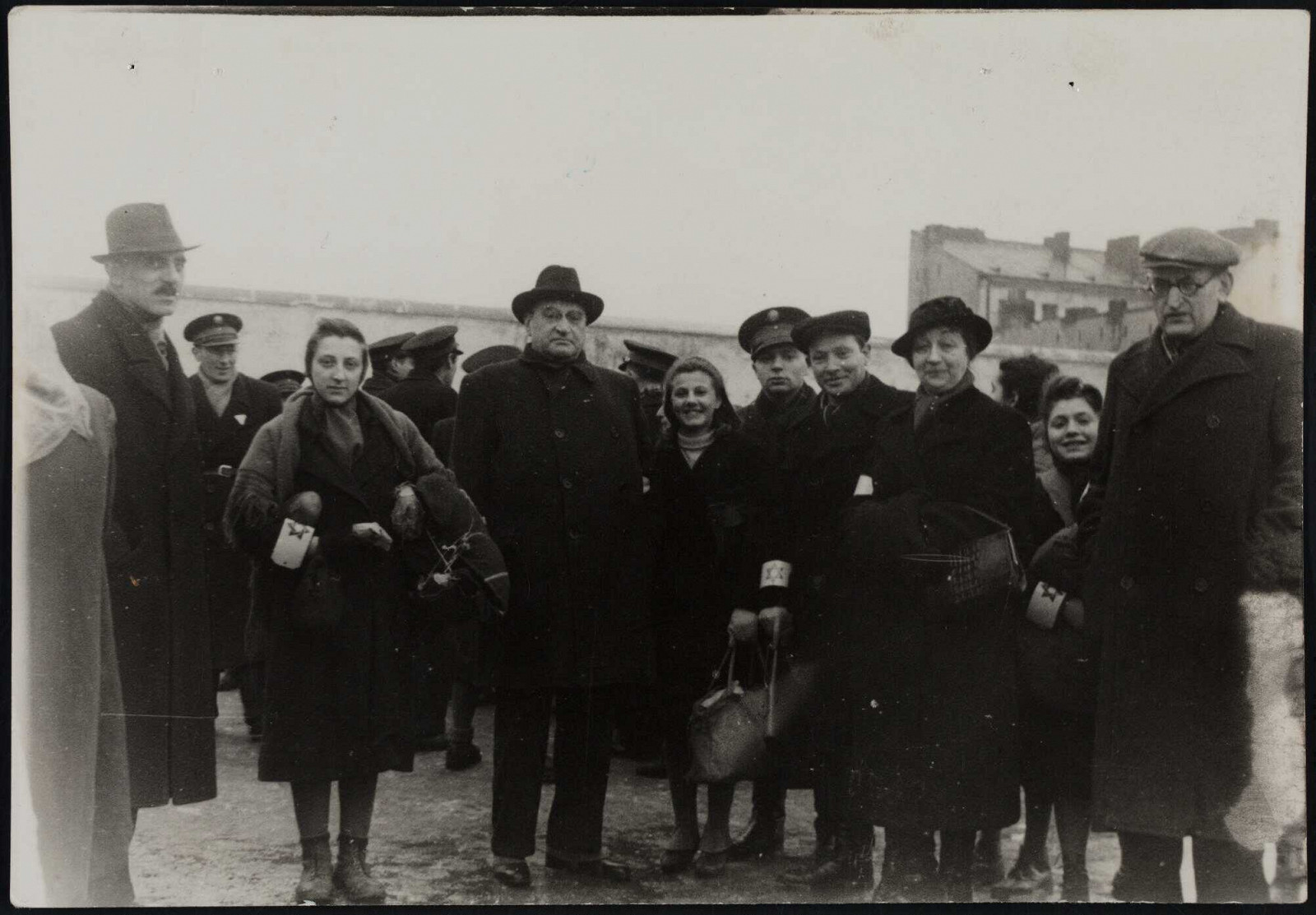- News
- Events
- Oneg Shabbat
- Collections
- Research
- Exhibitions
- Education
- Publishing Department
- Genealogy
- About the Institute
- Bookstore


’What a beautiful view it was! A fantastic image from a painterly, a theatrical point of view. The officer of the sappers unit gave me an electric apparatus which detonated the explosives. I was prolonging the moment. Eventually, I shouted: Heil Hitler! – and I pressed the button. An explosion of fire flew up to the clouds. A deafening noise. A magic spectacle of colors. An unforgettable allegory of triumph over Jewry. The Warsaw Ghetto ceased to exist’ (transl. by Olga Drenda). This was how SS general Jürgen Stroop described the blowing up the Great Synagogue in Tłomackie Square to Kazimierz Moczarski, the author of Conversations with an Executioner. On May 16, 1943, the largest synagogue in Warsaw was demolished. It was meant to be a symbolic confirmation of the suppression of the uprising and liquidation of the Warsaw ghetto.
In the Jewish Historical Institute, we have been trying for years to look at the anniversaries from different perspectives. In March last year, we commemorating the 75th anniversary of the unmasking of the ‘Krysia’ bunker where Emanuel Ringelblum was hiding with his family. At the end of our celebrations, we made a social action on the anniversary of his birthday. Many of our initiatives follow this scheme. Starting from 2013, the March of Remembrance, organized by us on the day of the commencement of the great liquidation of the Warsaw Ghetto, on July 22, travels the streets of the capital along the symbolic route from „death to life”. The procession begins at the site of the former Umschlagplatz, from where Jews were transported to the Treblinka extermination camp, and ends at a place associated with the hero of a given March.
This year, we focus on the 80th anniversary of the closing of the Warsaw Ghetto. On November 16, 1940, Warsaw Jews were cut off from the rest of the city, their families on the so-called ‘Aryan side’ and the whole world. The ghetto functioned for over two and a half years, costing the lives of hundreds of thousands of people. Blowing up the Great Synagogue in Tłomackie was considered by the Germans its symbolic end. Thanks to the works and documents preserved in the collections of the Jewish Historical Institute we are aware of the ghetto inhabitants’ feeling, thoughts, fears and hopes. Making use of these materials, we want to pay tribute to the largest Jewish community of pre-war Europe and to popularize knowledge about these tragic events.
As in previous years, we inaugurate our activities in the scheme ‘from death to life’. Here are our plans to celebrate the 80th anniversary of the closing of the ghetto on the anniversary of its symbolic liquidation.
We have planned a number of events for 2020. Beginning with the presentation of the work of the Jewish artist Symcha Trachter, through the organization of the ninth March of Remembrance on July 22 – this year it is dedicated to Adam Czerniakow, president of the Judenrat in the Warsaw Ghetto – and the solemn celebration of the rebellion of prisoners of the Treblinka II death camp together with an exhibition at the Treblinka Museum dedicated to Janusz Korczak, as well as activities dedicated to the Great Synagogue in Tłomackie and the opening of exhibition about the Warsaw Ghetto: ‘Where are you?’.

On the 78th anniversary of the start of the liquidation action of the Warsaw Ghetto, we organize the July 22 Remembrance March to commemorate the victims and pay tribute to the largest Jewish community of pre-war Europe. This year’s March will especially commemorate the figure of Adam Czerniaków – educator, social activist and publicist, city councilor of Warsaw, senator of the Republic of Poland. In the Warsaw ghetto he was the president of the Judenrat. On July 22, 1942, he refused to sign an announcement about the forced eviction of Jews from Warsaw, which in fact meant deportation to the Treblinka extermination camp. On the next day, July 23, Czerniaków committed suicide.
A symbolic route ‘from death to life’ will lead us from the Umschlagplatz monument on Chłodna 20 street, to Kamienica pod Zegarem [Tenement Under The Clock], where Adam Czerniaków lived. This year, we will allow everyone to travel individually, with a map specially prepared for this event (in paper version and downloadable on mobile devices). At the destination, on Chłodna street, an artistic installation will be created, to which you will be able to attach a Memorial Ribbon with a name. The march will be accompanied by a publication of fragments of Adam Czerniaków’s Diary from the time when he lived at Chłodna street. In the period from July 22 to September 21 this year, referring to the duration of the Great Deportation from the Warsaw Ghetto, we are planning a series of scientific and artistic events supported by a wide information campaign.
Referring to the July 22 March of Remembrance and the liquidation of the Warsaw Ghetto, from which 6,000 to 8,000 Jews were deported to the Treblinka extermination camp every day, we will celebration the August 1943 rebellion. In Treblinka, people were being murdered since July 23, 1942, when the first transport with Jews from the Warsaw Ghetto entered the railway station at Treblinka II camp. By November 1943, around 900,000 people have died there.
This year, we are symbolically planning to pay homage to all those murdered by means of artistic activities.
Henryk Goldszmit, known to the world as Janusz Korczak, shared the fate of his Jewish countrymen and pupils from the orphanage, being deported in the summer of 1942 to the Treblinka extermination camp. As the only person he has a stone in the Treblinka Museum as part of the monumental foundation commemorating the victims of the Holocaust. Groups visiting the Museum in large numbers pay special attention to this extraordinary figure. Our goal is to present his biography as well as his literary and pedagogical achievements.
planned opening: 2nd half of August 2020
The exhibition under the working title Symcha Trachter (1894–1942). Light and color will be a presentation of the achievements of one of the most outstanding Polish painters of the interwar period.
This exhibition will be a summary of many years of research on the artist’s legacy. The creators of the exhibition, based on surviving paintings and drawings, as well as reproductions of the artist’s preserved or missing works, known from the press, will show how Trachter’s style was changing over his life.
By referring to the cities and towns with which he was associated, and showing the impact on his work of European artistic environments such as École de Paris, visitors will be able to see the evolution in Trachter’s technique and colors. The artist experimented with paint, sometimes deliberately leaving fragments of the canvas unpainted and even unprimed. He employed various techniques to achieve an harmonious, and at the same time expressive composition. These thoughtful efforts created his original style, distinguishing his works from art of interwar Poland.
Trachter’s life and work in the Warsaw ghetto, where he created his last and unique work, the Job wall painting, will be strongly emphasized at the exhibition. This polychrome decorating one of the rooms of the Judenrat has not survived. We know its description from documents preserved in the Ringelblum Archive.
The publication devoted to the work of the painter Symcha Trachter will accompany his monographic exhibition.
Almost all surviving images will be shown in the catalog and Trachter’s drawings, supplemented with several unsaved or missing works known from reproductions in the interwar press. This collection will be a small but representative part of his enormous output absorbed by World War II. The publication will be supplemented with an artist’s biography and discussion of his work.
The Great Synagogue on Tłomackie Street was located in the heart of pre-war Jewish Warsaw. It was a witness to the Jews’ spiritual resistance and death during the Holocaust. This important building was opened over 140 years ago on a special holiday for Jews, Rosh Hashanah (New Year), which this year falls in mid-September. During this time, we would like to remind you of this important place, which tragically became a symbol of the final liquidation of the Jewish quarter in May 1943. During the event, there will be a presentation of an interdisciplinary project showing the inspiration of the Warsaw synagogue outside of Poland, which in this way lives on, although it no longer exists physically.
On November 16, 1940, the German occupier closed the walls of the Warsaw Ghetto. From then on, every Jew outside of the walls was treated as the worst offender. The humiliating separation of the Jewish population was the first stage of the upcoming horror.
The exhibition symbolically refers to this moment. Instead of a typical chronological and factual narrative, we propose another approach, in which the authors of the exhibition try to familiarize visitors with the emotional and existential state that hundreds of thousands of people crowded in the central part of Warsaw experienced behind the walls.
We will use three types of source material – accounts and witness records collected in the Ringelblum Archive, drawings and photographic documentation. Carefully selected texts, entirely related to the largest of the Jewish ghettos in Poland, will be assigned to subsequent categories of experience, and then recorded in two or three language versions (Polish, English, Yiddish) and made available as audioguides.
The architecture of the exhibition and the way visitors move around it are intended to raise awareness about the ghetto experience – without, however, attempting to stage a drama or use expressive scenery. We would like viewers to find a universal message in the state of crisis that we touch at the exhibition, which also applies to other places and events.